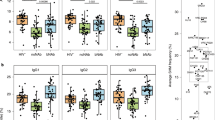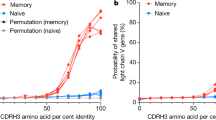Abstract
Although recent advances in the study of the molecular genetics of the antibody system have greatly increased our understanding of the generation of immunological diversity1–7, the state of B-cell differentiation at which diversification and specificity commitment occur has yet to be determined. In particular, it is unclear whether the entire repertoire of antibody specificities in an individual is expressed in the absence of selective forces, such as antigenic stimulation or network regulation. It has recently been suggested that some elements of variable region diversification, particularly somatic mutations, may accompany the shift from the IgM to IgG isotype8–10. These findings support the view that much of B-cell repertoire diversity is the result of antigen-driven somatic events, because isotype shifts normally occur after antigenic stimulation11–13. As these experiments used antibodies obtained after at least one in vivo antigenic stimulation, they do not address the possibility that the selection occurring during clonal expansion and subsequent IgG synthesis may favour the use of clones expressing unique antibody specificities (clonotypes) far removed from the innate or frequently occurring germ-line sequences. To test whether B-cell diversification may precede IgM expression, we have now determined the range of diversity available in the primary IgM antibody repertoire by studying the clonal heterogeneity of monoclonal IgM antibodies expressed by BALB/c mice in response to phosphorylcholine (PC). Our results indicate that the repertoire of IgM antibodies in an inbred murine strain exceeds 107 clonotypes. This diversity is sufficiently large to preclude meaningful comparisons between the IgM and IgG repertoires and suggests that antibody diversification may occur early in B-cell differentiation.
This is a preview of subscription content, access via your institution
Access options
Subscribe to this journal
Receive 51 print issues and online access
$199.00 per year
only $3.90 per issue
Buy this article
- Purchase on Springer Link
- Instant access to full article PDF
Prices may be subject to local taxes which are calculated during checkout
Similar content being viewed by others
References
Sakano, H., Huppi, K., Henrich, G. & Tonegawa, S. Nature 280, 288–294 (1979).
Max, E., Seidman, T. & Leder, P. Proc. natn. Acad. Sci. U.S.A. 76, 3450–3454 (1979).
Weigert, M., Gatmaitan, M., Loh, E., Shilling, J. & Hood, L. Nature 276, 785–790 (1978).
Rabbitts, T. H., Matthyssens, G. & Hamlyn, P. H. Nature 284, 238–243 (1980).
Corey, S. & Adams, J. M. Cell 19, 37–51 (1980).
Crews, S., Griffin, J., Huang, H., Calame, K. & Hood, L. Cell 25, 59–60 (1981).
Selsing, E. & Storb, U. Cell 25, 47–58 (1981).
Gearhart, P., Johnson, N. D., Douglas, R. & Hood, L. Nature 291, 29–34 (1981).
Rodwell, J. D. & Karush, F. Molec. Immun. 17, 1553–1561 (1980).
Chang, S. P. & Rittenberg, M. B. J. Immun. 126, 975–980 (1981).
Gearhart, P. J. & Cebra, J. J. J. exp. Med. 149, 216–227 (1979).
Okumura, K., Julius, M. H., Psu, T., Hertzenberg, L. A. & Hertzenberg, L. A. Eur. J. Immun. 6, 467–472 (1976).
Teale, J. M., Lafrenz, D., Klinman, N. R. & Strober, S. J. Immun. 126, 1952–1957 (1981).
Klinman, N. R. J. exp. Med. 136, 241–260 (1972).
Gearhart, P. J., Sigal, N. H. & Klinman, N. R. J. exp. Med. 145, 876–891 (1977).
Gearhart, P. J., Sigal, N. H. & Klinman, N. R. Proc. natn. Acad. Sci. U.S.A. 72, 1707–1711 (1975).
Stashenko, P. & Klinman, N. R. J. Immun. 125, 531–537 (1980).
Karjalainen, K., Bang, B. & Makela, O. J. Immun. 125, 313–317 (1980).
Press, J. L. & Klinman, N. R. Immunochemistry 10, 621–627 (1973).
Klinman, N. R. & Press, J. L. J. exp. Med. 141, 1133–1146 (1975).
Briles, D. E. & Carroll, R. J. Molec. Immun. 18, 29–38 (1981).
Pierce, S. K. & Klinman, N. R. J. exp. Med. 142, 1165–1179 (1975).
Klinman, N. R., Wylie, D. E. & Cancro, M. P. in Immunology 1980—Progress in Immunology Vol. 4 (eds Fougereau, M. & Dausset, J.) 123–135 (Academic, London, 1980).
Author information
Authors and Affiliations
Rights and permissions
About this article
Cite this article
Owen, J., Sigal, N. & Klinman, N. Heterogeneity of the BALB/c IgM anti-phosphorylcholine antibody response. Nature 295, 347–348 (1982). https://doi.org/10.1038/295347a0
Received:
Accepted:
Issue Date:
DOI: https://doi.org/10.1038/295347a0
This article is cited by
-
Temporal variations in the fine specificity of IgM anti‐fluorescyl antibodies
Immunology & Cell Biology (1991)
-
Developmental aspects of B-cell repertoire phenotype
Survey of Immunologic Research (1983)
Comments
By submitting a comment you agree to abide by our Terms and Community Guidelines. If you find something abusive or that does not comply with our terms or guidelines please flag it as inappropriate.



